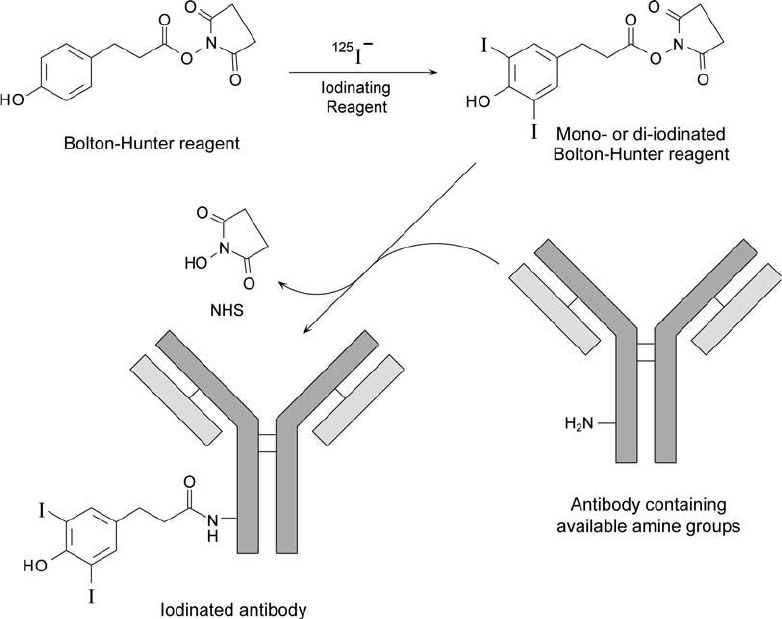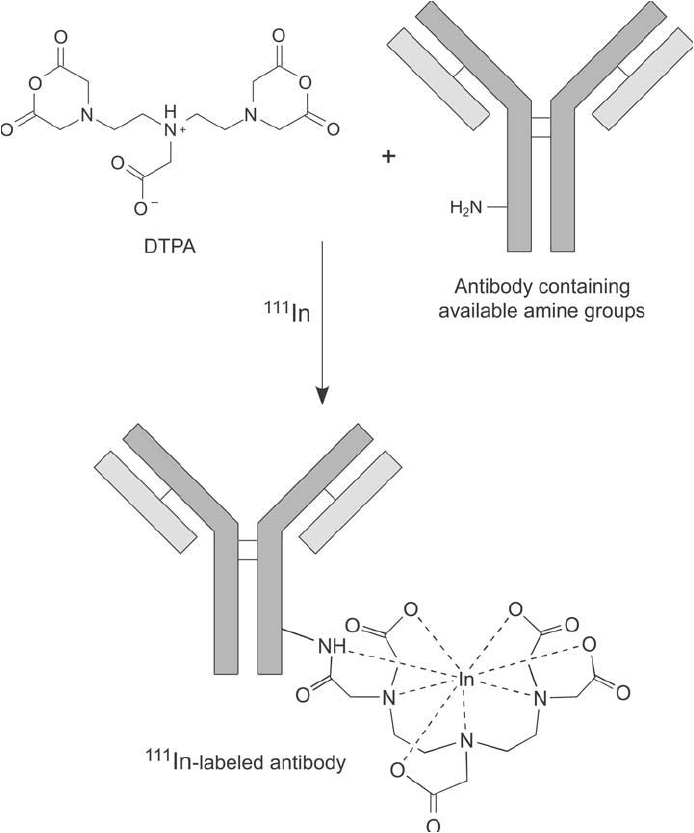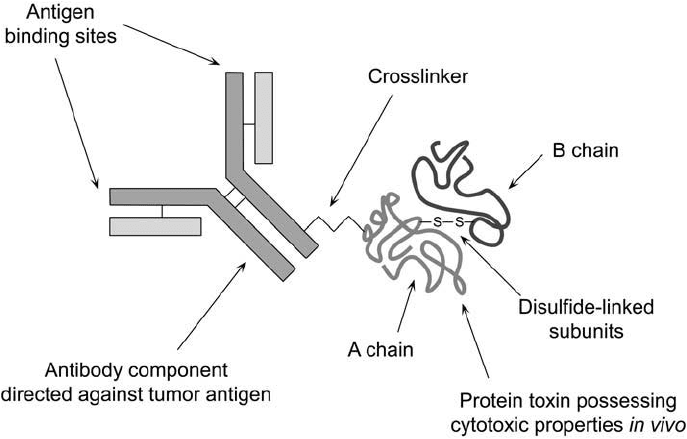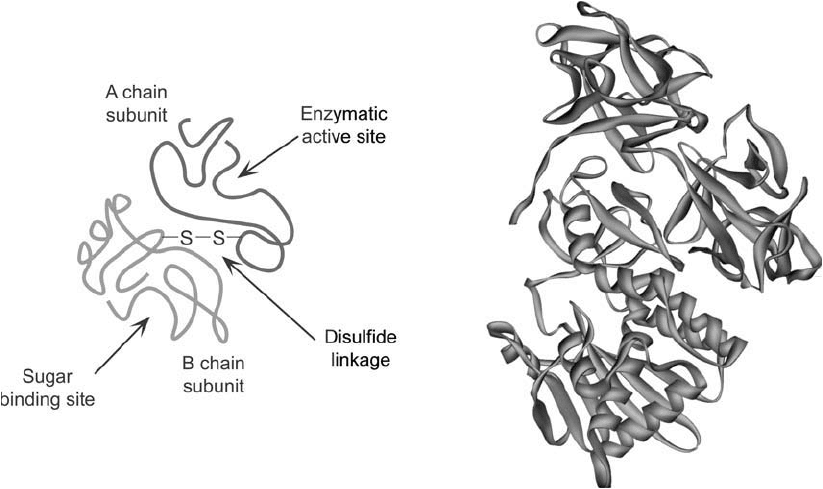Hermanson G. Bioconjugate Techniques, Second Edition
Подождите немного. Документ загружается.


820 20. Antibody Modifi cation and Conjugation
Reagent options and protocols for the radioiodination of antibodies and other molecules
may be found in Chapter 12.
Another method of adding a radioactive tag to antibodies is to use a chelating compound
capable of complexing metal isotopes. One of the most frequently used chelating reagents is
diethylenetriamine pentaacetic acid (DTPA) (Chapter 10, Section 1). The reagent contains two
anhydride groups that can be used to modify primary amines in proteins and other molecules.
The reaction process involves ring opening and the formation of an amide bond. Ring open-
ing also creates up to four free carboxylate groups which, combined with the three nitrogen
atoms in the chelator, are able to form str820ong coordination complexes with metals such as
indium-111 ( Figure 20.18 ). Monoclonals labeled with chelated isotopes can be used in target-
ing tumor cells in vivo. The detection sensitivity of radiolabeled antibodies has led to effec-
tive diagnostic procedures to monitor primary and secondary cancer growths. In addition, the
intensity of radioactivity at the tumor site when labeled monoclonals are targeted therapeuti-
cally can be great enough to cause tumor cell death and remission.
Figure 20.17 Bolton–Hunter reagent may be used to add radioactive iodine labels to antibody molecules by
modifi cation of amines.

2.3. Biotinylated Antibodies
Another popular tag for use with immunoglobulins is biotin. Modifi cation reagents that can
add a functional biotin group to proteins, nucleic acids, and other molecules now come in many
shapes and reactivities (Chapter 11). Depending on the reactive group present on the biotinylation
Figure 20.18 The bifunctional chelating reagent DTPA may be used to modify amine groups on antibody mol-
ecules, forming amide bond linkages. Indium-111 then may be complexed to the chelator group to create a
radiolabeled-targeting reagent.
2. Preparation of Labeled Antibodies 821

822 20. Antibody Modifi cation and Conjugation
reagent, specifi c functional groups on antibodies may be modifi ed to create an affi nity tag
capable of binding avidin (or streptavidin) derivatives. Amines, carboxylates, sulfhydryls,
and carbohydrate groups can be specifi cally targeted for biotinylation through the appropriate
choice of reactive biotin compound. Figure 20.19 shows the biotinylation of an antibody with
NHS-LC-biotin, one of the most common biotinylation reagents.
The presence of biotin labels on an antibody molecule provides multiple sites for the binding
of avidin or streptavidin. If the biotin binding protein is in turn labeled with an enzyme, fl uoro-
phore, etc., then a very sensitive detection system is created. The potential for more than one
labeled (strept)avidin to become attached to each antibody through multiple biotinylation sites
provides an increase in detectability over antibodies directly labeled with a detectable tag.
Several assay designs that use the enhanced sensitivity afforded through biotinylated anti-
bodies have been developed. Most of these systems use conjugates of avidin or streptavidin
Figure 20.19 Biotinylated antibodies can be formed by reacting NHS-LC-biotin with available amine groups to
create amide bonds.
with enzymes (such as HRP or AP), although other labels (such as fl uorophores) can be used as
well. In the simplest assay design, called the labeled avidin–biotin (LAB) system, a biotinylated
antibody is allowed to incubate and bind with its target antigen. Next, an avidin–enzyme con-
jugate is introduced and allowed to interact with the available biotinylation sites on the bound
antibody. Substrate development then provides the detectability necessary to quantify the
antigen.
In a slightly more complex design, the bridged avidin–biotin system (BRAB) uses (strept)
avidin’s multiple biotin binding sites to create an assay potentially of higher sensitivity than
that of the LAB assay. Again, the biotinylated antibody is allowed to bind its target, but next
unmodifi ed (strept)avidin is introduced to bind with the biotin binding sites on the anti-
body. Finally, a biotinylated enzyme is added to provide a detection vehicle. Since the bound
(strept)avidin still has additional biotin binding sites available, the potential exists for more
than one biotinylated enzyme to interact with each bound (strept)avidin molecule. In some
cases, sensitivity can be increased over that of the LAB technique by using the bridging ability
of avidin or streptavidin (Chapter 23, Section 2).
A modifi cation on this theme can be used to produce one of the most sensitive enzyme-
linked assay systems known. The ABC system (for avidin–biotin complex) increases antigen
detectability beyond that possible with either the LAB or BRAB designs by forming a polymer
of biotinylated enzyme and (strept)avidin before addition to an antigen-bound, biotinylated
antibody. When avidin and a biotinylated enzyme are mixed together in solution in the proper
proportion, the multiple binding sites on (strept)avidin create a high molecular weight, mul-
timeric complex. If the biotinylated enzyme is not in large enough excess to block the binding
sites on all the (strept)avidin molecules, then additional sites will still be available on this com-
plex to bind a biotinylated antibody bound to its complementary antigen. The large complex
provides multiple enzyme molecules to enhance dramatically the sensitivity of detecting anti-
gen. Thus, the ABC procedure is currently among the highest-sensitivity methods available for
immunoassay work.
More detailed discussions of avidin–biotin systems as well as the process of adding a biotin
affi nity group to proteins, nucleic acids, and other biomolecules can be found in Chapters 11
and 23.
2. Preparation of Labeled Antibodies 823

21
Monoclonal antibodies directed against tumor antigens may be used as targeting agents for
conducting certain cytotoxic substances to malignant cells for selective killing. Numerous cell-
surface markers are known to proliferate in human solid tumors (Boyer et al., 1988; Carter
et al., 2004). The ability to raise mono-specifi c antibodies to these markers creates the capac-
ity to target discretely the tumor, causing cell death while leaving healthy cells alone (Salmon,
1989; McCarron et al ., 2005).
The design of such cytotoxic antibodies is conceptually simple: attach a toxic substance or
a mediator of toxicity to the appropriate monoclonal and you have a “magic bullet ” that can
fi nd and eliminate the one-in-a-billion cells that have the requisite marker ( Figure 21.1 ). The
antibody provides the recognition and binding capacity, while the associated toxic component
effects cellular alterations leading to cell death (Pastan et al ., 2006).
The approach to constructing antibody immunoconjugates for cancer has taken a number
of forms (Vogel, 1987). One of the fi rst designs used conjugates of monoclonal antibodies with
toxins that were able to block protein synthesis at the ribosome level inside the cell (Lord et al .,
1988). Other conjugate forms used radioactive labels that killed cells by over-exposure to radi-
ation in proximity to where antibody docking occurred (Order, 1989). Drug conjugates also
were constructed that combined the known benefi ts of chemotherapy with the targeting capa-
bility of monoclonals (Reisfeld et al., 1989; Willner et al., 1993). The expected result was the
effective concentration of the chemotherapeutic agent at the location of the tumor—hopefully
eliminating or minimizing the side-effects of traditional chemotherapy. In addition, conjugates
of monoclonals with certain biological modulators such as lymphokines or growth factors were
tried to affect malignant cell viability (Obrist et al ., 1988).
Some immunoconjugates utilize intermediate carrier systems consisting of polymeric mol-
ecules such as polysaccharides, particularly dextran (Hurwitz et al., 1978, 1980, 1983a, b,
1985; Manabe et al., 1983; Sela and Hurwitz, 1987). The activated dextran is crosslinked to
both the monoclonal and the cytotoxic agent, providing multivalent conjugation sites to create
larger complexes (Section 2.3, this chapter and Chapter 25, Section 2). Liposomes can be used
in similar fashion by anchoring the antibody to its outer surface and charging the vesicle with
cytotoxic compounds (Gregoriadis, 1984; Matthay et al., 1986; Singhal and Gupta, 1986; Ho
et al., 1986). See Chapter 22 for a survey of liposome conjugation techniques. Also, dendrimer
Immunotoxin Conjugation Techniques
824

conjugates with antibody-targeting molecules and cytotoxic components have been used to cre-
ate multivalent immunotoxin conjugates (Chapter 7).
Other systems were designed to use two-stage approaches where an antibody was conjugated
with an intermediate agent, which, when combined with another factor, could elicit cytotoxic-
ity. For instance, enzyme conjugates with monoclonals have been used that could transform an
inactive pro-drug into a chemotactic agent in vivo (Senter et al., 1988). Monoclonals also could
be tagged with a biotin label and a secondary, avidin–toxin conjugate used to target the anti-
body once it bound the tumor cell. Two-stage radiative treatment also has been tried through
the use of boron neutron capture therapy (Holmberg and Meurling, 1993). In this case, a carrier
molecule is modifi ed to contain
10
B. After administration in vivo to target tumor cells, neutron
bombardment yields an unstable intermediate
11
B which immediately undergoes a fi ssion reac-
tion to yield
7
Li and
4
He. The induced radiation then kills the cells.
Tumor-targeting conjugates which use biospecifi c agents other than monoclonal antibodies
have been developed as well. The targeting component in these systems consists of any mol-
ecule that can function as a ligand having specifi c affi nity for some receptor molecule on the
surface of the tumor cells. Such an affi nity molecule might be a hormone (typically called hor-
monotoxins; Singh et al., 1989, 1993), a growth factor, an antigen specifi c for binding particu-
lar antibodies projecting from B cell surfaces, transferrin,
2
-macroglobulin, or anything else
able to specifi cally interact with the targeted tumor cells.
It became apparent very early in the development of such agents that their conception and
design was much easier to imagine than to successfully implement. Monoclonal antibodies used
Figure 21.1 The basic design of an immunotoxin conjugate consists of an antibody-targeting component
crosslinked to a toxin molecule. The complexation typically includes a disulfi de bond between the antibody
portion and the cytotoxic component of the conjugate to allow release of the toxin intracellularly. In this illus-
tration, an intact A–B toxin protein provides the requisite disulfi de, but the linkage also may be designed into
the crosslinker itself.
21. Immunotoxin Conjugation Techniques 825
in vitro could easily detect antigen molecules in complex mixtures with very little nonspecifi city
or cross-reactivity. Very quickly following the invention of hybridoma technology, monoclonals
were employed in numerous diagnostic assays. Their use as therapeutic agents in vivo, how-
ever, was complicated by the body ’s natural immune response designed to prevent the invasion
of foreign substances. At the time of this writing, there only are six unconjugated antibody
therapeutics approved for use in the U.S.A along with two radioimmunoconjugates, which use
a monoclonal antibody labeled with a radioactive metal ion. The only immunotoxin conjugate
employing an antibody–phytotoxin conjugate is Mylotarg, a conjugate of an anti-CD33 mono-
clonal with a calicheamicin derivative (an anti-tumor antibiotic) (Bross et al ., 2001).
A major problem in the use of immunotoxins is that injection of conjugates prepared
from mouse monoclonals usually results in antibody production against the foreign protein.
Sometimes allergic reactions can further complicate the side-effects, making continued therapy
infeasible. Most often, however, induced host immunoglobulins will quickly bind the immu-
noconjugate and remove it from the circulatory system. Instead of fi nding the targeted tumor
cells, the immunotoxin ends up sequestered and degraded in the liver or removed by the kid-
neys. Since the common culprit in this scenario often is the monoclonal, the acronym HAMA,
for human anti-mouse antibody , is given to the response.
In an attempt to overcome the HAMA problem, “humanized” mouse monoclonals were
designed where large portions of the murine antibody are substituted for their human coun-
terparts. For instance, replacing a mouse Fc portion with the corresponding human ones can
signifi cantly decrease the immune response against such conjugates. Replacing everything
but the hypervariable regions which code for antigen binding has been accomplished, too.
Unfortunately, regardless of how much “humanization” is done, the remaining murine part still
has the potential of causing immunological reactions. The advent of recombinant antibodies of
completely human origin essentially has overcome the problem of immune system response to
the antibody component. However, there still is the potential for generating an immune response
from the toxic part of the immunoconjugate, but this is unavoidable unless immune modulators
are administered to reduce the overall immune system responsiveness.
Modifi cation of immunotoxin conjugates with synthetic polymers has been used to mask
the complex from the host immune response. Particularly, polyethylene glycol (PEG; Chapter
25, Section 1 and Chapter 18) has been found to be quite successful in reducing or eliminating
immune system reactions (Roffl er and Tseng, 1994). Modifi cation of an antibody conjugate
with 2–4 PEG molecules increases the serum half-life and improves tumor localization of the
targeted reagent.
Other innovations in preparing targeted conjugates for cancer utilize recombinant DNA tech-
niques to create antibody molecules that are entirely of human origin (Huse et al., 1989; Orlandi
et al., 1989; Sastry et al., 1989; Hudson and Souriqu, 2007). A completely human antibody
molecule eliminates the immunological problems associated with mouse monoclonals. Intact
antibodies, Fab fragments, small Fv fragments held together by synthetically designed amino
acid segments, and short peptides representing the antigen binding site have all been developed
by recombinant means. Although frequently the word “antibody” is used to describe these engi-
neered proteins, many of the molecules are far removed from the traditional picture of an anti-
body molecule. The terms “single chain antibody ” or “single chain Fv protein ” are commonly
used and more closely describe these new targeting molecules.
With the great diversity of targeted toxic agents being developed for cancer therapy, it
would be diffi cult to characterize this section strictly as antibody conjugation. While many,
826 21. Immunotoxin Conjugation Techniques
if not most, studies utilize monoclonal antibodies of one form or another as the biospecifi c-
targeting component, the complete picture involves the crosslinking of a wide variety of mol-
ecules together to create the fi nal conjugate. This section presents some of the most common
methods of immunotoxin preparation. For the preparation of other unique targeted toxin con-
jugates, the methods found throughout this book for linking one particular functional group to
another can be followed with an excellent probability for success.
1. Properties and Use of Immunotoxin Conjugates
Conjugates of monoclonal antibodies and protein toxins are undergoing extensive research for
their usefulness in the treatment of cancer. Toxins of many different types can be used to cre-
ate effective immunotoxin conjugates, including the proteins ricin from castor beans ( Ricinus
communis), abrin from Abrus precatorius, modeccin, gelonin from Gelonium multifl orum
seeds, diphtheria toxin produced by Corynebacterium diphtheriae, pokeweed antiviral proteins
(PAPs; three types: PAP, PAP-II, and PAP-S) from Phytolacca americana seeds, cobra venom
factor (CVF), Pseudomonas exotoxin, restrictocin from Aspergillus Restrictus, momordin from
Momordica Charantia seeds, saporin from Saponaria offi cinalis seeds, as well as other ribosome-
inactivating proteins (RIPs).
By far the most popular choices for the toxin component of immunotoxins are ricin, abrin,
modeccin, and diphtheria toxin. The three plant toxins have lectin binding activity toward
terminal -galactosyl residues and they can be inhibited by the presence of simple sugars like
galactose and lactose. The toxin proteins bind to cell-surface polysaccharide receptors with high
affi nity (k
a
in the range of 10
7
–10
8
). Ricin, abrin, and modeccin consist of two subunits with
remarkably similar structures and activities. The intact proteins have molecular weights (MW)
of approximately 63–65,000 with each subunit of about equal size. The subunits are joined by
disulfi de linkages that are important reversible bonds in the mechanism of cytotoxicity. The A
chain is called the effectomer and possesses ribosomal-inactivating properties. The B chain con-
tains the carbohydrate binding site and it is termed the haptomer. While the intact toxin mol-
ecules have potent cytotoxic effects on cells, they exhibit no ribosomal-inactivating activity on
ribosomes in a cell-free system. By contrast, reduction of the toxins with a disulfi de reducing
agent creates the opposite effects. Reduced, dissociated toxin subunits inhibit ribosomal activity
in cell-free systems, but they have no affect on intact cells.
The reason for these properties is due to the toxins ’ mode of action. Toxin molecules bind
through saccharide-recognition sites on the B chain to particular -galactosyl-containing glyc-
oprotein or glycolipid components on the surface of cell membranes. In animals sensitive to
these toxins, the necessary polysaccharide ligands are present in large quantities on virtually
all cell types (Cumber et al., 1985). Upon binding of the dimer to the cell, the A chain enters
the cell either by active transport into endocytic vesicles or through some mechanism of its
own. Once inside the cell membrane, the A chain enters the cytoplasmic space, binding to and
enzymatically inactivating the 60S subunit of ribosomes (Olsnes and Pihl, 1976, 1982). The
result is cessation of protein synthesis and eventual cell death. Because the A chain ’s action is
through enzymatic means, as little as one active toxin molecule is enough to seriously disrupt
protein synthesis operations and probably suffi cient to kill a target cell (Eiklid et al., 1980).
The turnover rate of one A-chain molecule is about 1,500 ribosomes inactivated per minute
(Olsnes, 1978).
1. Properties and Use of Immunotoxin Conjugates 827

Diphtheria toxin also is a two-subunit protein, but it is initially synthesized by certain strains
of Corynebacterium diphtheriae as a single polypeptide chain of MW 63,000. Proteolytic
processing results in the formation of a “nicked toxin ” which is enzymatically inactive, but
consists of two subunits bonded together by an interchain cystine disulfi de. Upon reduction
of the disulfi de, the A chain (MW 24,000) is released and manifests enzymatic activity toward
ribosomal proteins (Sandvig and Olsnes, 1981; Collier and Cole, 1969). Its mode of action is
different than the plant toxins. The A-chain fragment of diphtheria toxin catalyzes the ADP-
ribosylation of eukaryotic aminoacyl-transferase II (EF2) using NAD
(Honjo et al., 1968; Gill
et al., 1969). The B chain, by contrast, possesses no enzymatic activity, but evidence points
to the fact that a binding site on it recognizes certain cell-surface receptors. As in the action
of ricin, abrin, and modeccin, the B chain of diphtheria toxin is necessary for cytotoxicity
(Colombatti et al., 1986). There also is a role for the C-terminus cysteine residue of the B chain
in cell penetration (Dell ’Arciprete et al ., 1988).
Figure 21.2 illustrates the basic structure of these common two-subunit toxins, showing
schematically their major characteristics. The molecular model of ricin is from Rutenber et al .
(1991), RSCB structure No. 2aai.
Due to the extraordinary toxicity of intact ribosome-inactivating toxins like ricin, abrin, and
modeccin, purifi cation and handling of these proteins must be done with extreme care. Even
dust from crude seed powders or lyophilized proteins should be considered dangerous. During
Figure 21.2 Conceptualized construction of an A–B subunit protein toxin (left). The B chain contains a binding
region for docking onto cell surfaces, while the A chain contains a catalytic site that produces cytotoxic affects
intracellularly. The two subunits are joined by a disulfi de bond that is reductively cleaved at the cellular level to
allow the A subunit to affect cell death. A molecular model of ricin is on the right.
828 21. Immunotoxin Conjugation Techniques
the height of the cold war days, a Soviet KGB agent killed a man from the West by injecting at
most only milligram quantities of ricin into his leg using a modifi ed umbrella tip. There even
have been instances of worker deaths at companies that routinely purify these proteins. For
this reason, all handling operations of intact toxin dimers and purifi ed subunits should be done
in fume or laminar-fl ow hoods. Avoid, also, the use of laboratory tools that could lead to punc-
ture wounds causing contaminating toxin injection.
Some potentially cytotoxic proteins contain only a single polypeptide chain, such as gelo-
nin and PAPs. Such toxins manifest similar enzymatic ribosome-inactivating properties as
the multi-subunit proteins like ricin, but do not possess the cell-recognition capacity that the
B-chain subunit contains. The result is the inability of these toxins to bind or affect intact cells.
However, they do maintain the typical ribosome-inactivating properties in a cell-free system
that the A chain of two-subunit toxins possess. If these proteins are conjugated with a cell-
targeting agent, such as the B chain of ricin or a specifi c antibody that recognizes cell-surface
epitopes, full cytotoxicity results.
Gelonin and PAPs are much more convenient to work with than ricin and the other two-
subunit toxins. Most importantly, they are relatively nontoxic to cells unless conjugated
with something that can facilitate cell binding and internalization (Stirpe et al., 1980; Irvin,
1983). The pI of these toxins is in the basic range, and they each have a MW of about 30,000
(Barbieri and Stirpe, 1982). These single-subunit proteins are very stable, especially to purifi ca-
tion techniques, but also to most modifi cation and crosslinking steps associated with preparing
immunotoxins. Studies have shown (Lambert et al., 1985) that modifi cation of gelonin or PAPs
can be done with 2-iminothiolane (Chapter 1, Section 4.1) to create sulfhydryl groups with-
out loss of activity. Previous studies, however, have determined that the use of SPDP to mod-
ify gelonin resulted in a 90 percent inactivation (Thorpe et al., 1981). The difference in these
results may be due to the retention of positive charge characteristics on the modifi ed amine
when using Traut ’s reagent, but neutralization of that charge when using SPDP.
Immunotoxin conjugates consist of an antibody covalently crosslinked to a toxin molecule
in a way that maintains the unique properties of both proteins. The antibody component con-
sists of a monoclonal having specifi city for an antigenic determinant on the surface of a par-
ticular cell type. Most often, the targeted cells are tumors that express a unique cell-surface
marker which can be recognized by the monoclonal. The role of the antibody, therefore, is
to function as a passive taxi, carrying the toxin component to the targeted cells. Once at the
tumor location, the toxin component effects its intended ribosome-inhibiting action, ultimately
causing cell death and tumor destruction.
Since immunotoxin conjugates are destined to be used in vivo, their preparation involves
more critical consideration of crosslinking methods than most of the other conjugation proto-
cols described in this book. The following sections discuss the problems associated with toxin
conjugates and the main crosslinking methods for preparing them.
2. Preparation of Immunotoxin Conjugates
It has become apparent that the method of crosslinking can dramatically affect the activity of
an immunotoxin in vivo. This is true not only with regard to possible direct blocking by the
crosslinker of the enzymatic active site which is responsible for inactivation of ribosomes, but
the chemistry of conjugation also is an important factor in proper binding and entry of the
2. Preparation of Immunotoxin Conjugates 829
